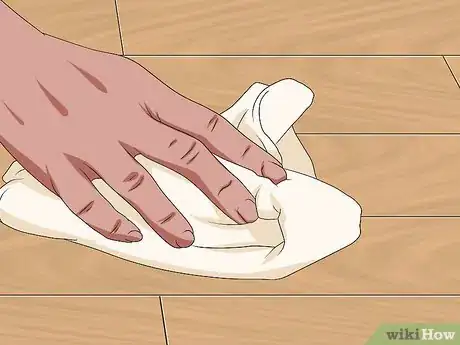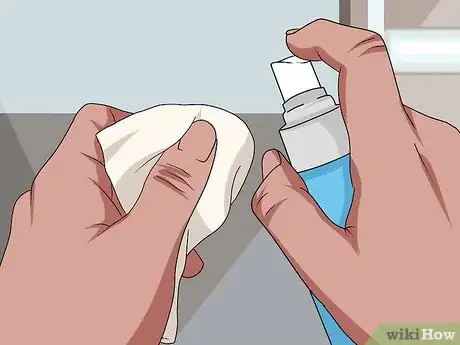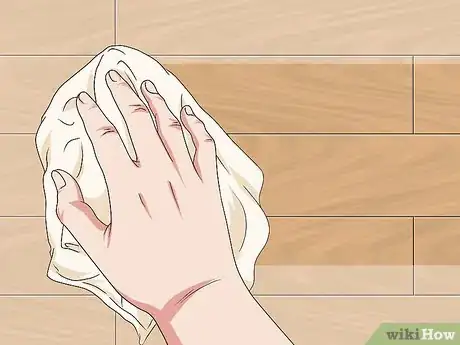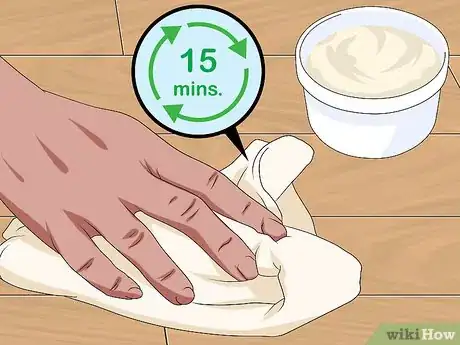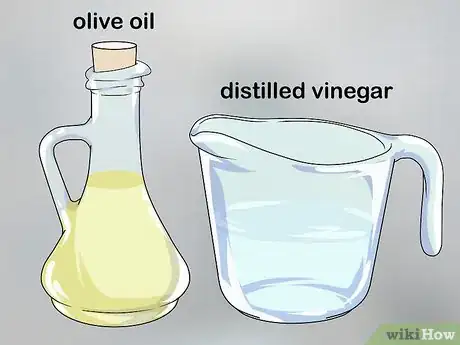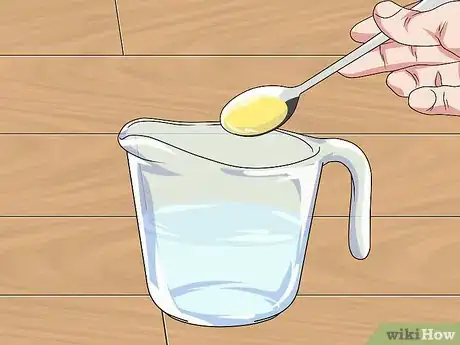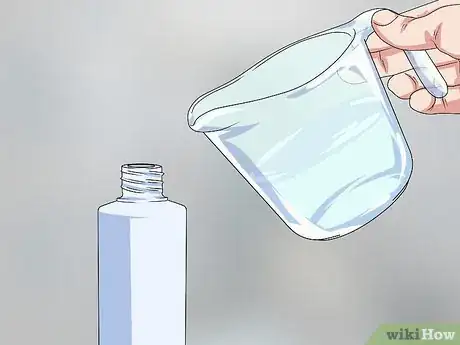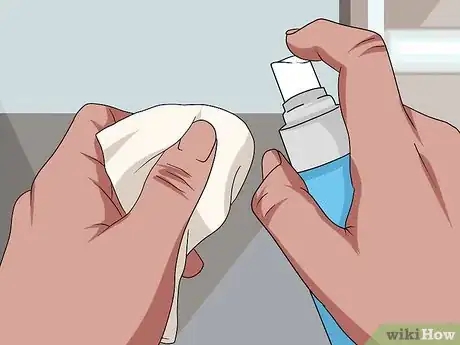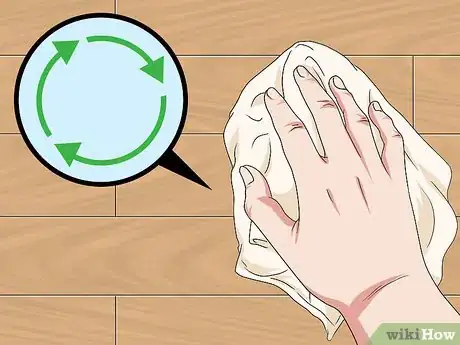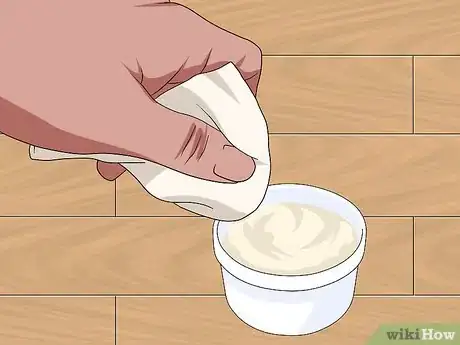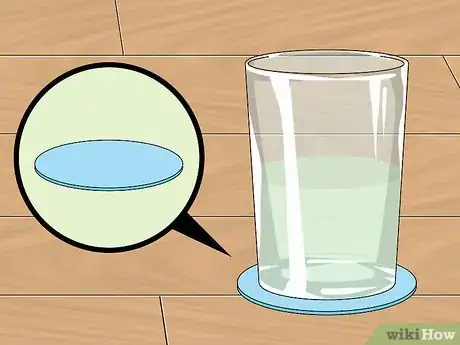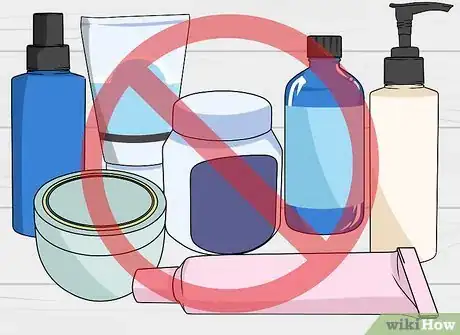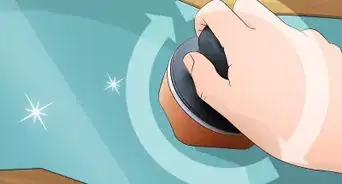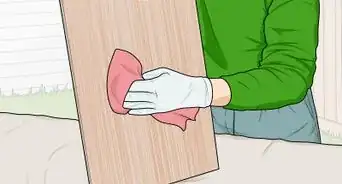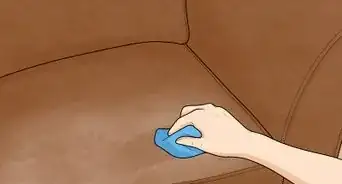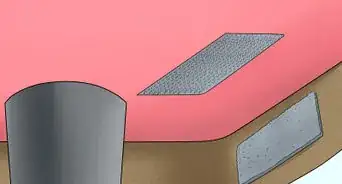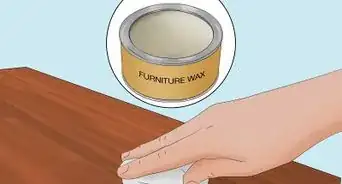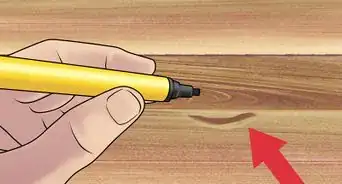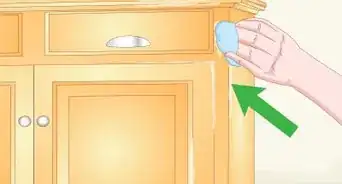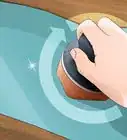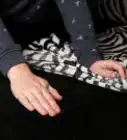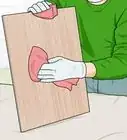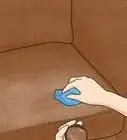X
This article was co-authored by wikiHow Staff. Our trained team of editors and researchers validate articles for accuracy and comprehensiveness. wikiHow's Content Management Team carefully monitors the work from our editorial staff to ensure that each article is backed by trusted research and meets our high quality standards.
This article has been viewed 18,725 times.
Learn more...
If your wood furniture has lost its lustrous gleam, it is time for you to polish it. Polishing is a good way to protect and preserve your wood furniture. The good news is that it’s a pretty easy process. There are many commercially available polishes as well as natural polishes you can make yourself.
Steps
Method 1
Method 1 of 3:
Applying a Commercial Wood Polish
-
1Clear off the surface you are going to polish. Wood polishes contain oil, so you want to be sure you’ve removed items that could be damaged by the polish. You also need to be able to clearly see the grain of the wood and if there are any trouble spots that need attention.
-
2Apply polish to a soft cloth or brush only. Do not spray or apply polish directly to the wood surface. Apply enough polish to moisten the cloth or brush, but avoid over-saturation. Too much polish will leave residue that will smear. [1]Advertisement
-
3Wipe with the grain. Move the moistened cloth or brush across the surfaces you want to polish following the grain of the wood. You should see an immediate effect. If you don’t see the results you desire, you can apply additional polish to your cloth and re-wipe the surface. [2]
-
4Treat stains and water rings. You can address many tough spots with a surprising household product: mayonnaise. Apply a small amount of mayo to the blemish and let it set for 15 minutes to an hour or two, depending on how tough the spot is. Then, use a cloth to wipe it away and reveal a restored surface.
- Note that you need a full-fat, traditional mayonnaise as opposed to light versions or mayonnaise substitutes. [3]
Advertisement
Method 2
Method 2 of 3:
Making Your Own Wood Polish With Olive Oil and Vinegar
-
1Gather supplies and ingredients. Along with olive oil and white distilled vinegar, you need a ¼ cup measuring cup. You also need a clean spray bottle. It is important not to use a container that previously had a cleaner or chemical in it. You risk contaminating your polish and potentially damaging the wood surface. [4]
-
2Measure ingredients. Various ratios can be used from ¼ cup olive oil and a few drops of vinegar to ¼ cup of vinegar to a few drops of olive oil. Experiment with the ratios to get the best result for your wood furniture. The vinegar acts as a cleaner, while the oil provides the polish and shine components. For darker woods, you can use apple cider vinegar.
- Do not use apple cider vinegar on light-colored woods, as it can cause staining. [5]
-
3Pour the measured ingredients into a clean spray bottle and mix them up. Secure the lid first to make sure the mixture doesn't leak. Then, gently shake your oil and vinegar mixture until it's combined. Once the polish is mixed well, you can use it!
-
4Polish your furniture. Spray a moderate amount of solution onto a clean cloth or soft brush. Do not spray it directly onto the wood surface. Then, follow the grain of the wood as you wipe the surface.
- If the polish leaves your furniture oily, add more vinegar to your mixture. If you don’t see enough shine after applying your polish, add more oil to your mixture.
Advertisement
Method 3
Method 3 of 3:
Doing Basic Maintenance
-
1Dust your furniture regularly. You don’t want to polish excessively as this can lead to a build-up of residue from your polishing agent. To prevent dust and debris in the air from creating a film on your furniture between polishes, use a clean, soft cloth, feather duster, or non-scratch cloth on the surface. [6]
-
2Clean up spills and stains. Accidents happen, but polish isn’t the answer. If there’s a stubborn, sticky spot, you can use the mayonnaise method. Alternatively, you can use soap and water.
- Dissolve a small amount of soap in water and put the cloth in the soapy water. Remove the rag, and wring it out well. You want it to be almost dry.
- Apply the cloth to the spot to remove the blemish. Rinse the soap and residue out of the cloth, and wipe the affected spot to remove any soap.
- Use a dry cloth to wipe up any remaining moisture. [7]
-
3Use coasters to prevent water rings and burn marks. Coasters provide a buffer between beverage containers and the surface of your furniture. Condensation from cold drinks will drip down the glass and form water rings. Hot drinks can burn a wood surface, leaving an unpleasant scar behind. Keep coasters handy, and encourage everyone in your household to use them. [8]
-
4Avoid using chemical products or solvents near the furniture. There are many substances that can eat through a wood finish or through wood itself. Alcohol can ruin a shellac surface, and most solvents will damage wood surfaces. Keep strong chemical substances like bleach and fingernail polish remover away from your wood furniture to prevent damage. [9]
Advertisement
Expert Q&A
-
QuestionHow do you get ink out of wood furniture?
 Erik BakirovErik Bakirov is a Cleaning Specialist at Room413 Cleaning in Los Angeles, California. Erik specializes in deep, move-in, and move-out cleaning services. Room413 matches homeowners with reliable and trustworthy cleaning services. They also promote environmentally friendly cleaning products.
Erik BakirovErik Bakirov is a Cleaning Specialist at Room413 Cleaning in Los Angeles, California. Erik specializes in deep, move-in, and move-out cleaning services. Room413 matches homeowners with reliable and trustworthy cleaning services. They also promote environmentally friendly cleaning products.
Cleaning Specialist The safest way to remove ink out of furniture without damaging it is to use a steamer, by steaming it out. Depending on how old the ink stain is, alcohol can be used to remove the ink.
The safest way to remove ink out of furniture without damaging it is to use a steamer, by steaming it out. Depending on how old the ink stain is, alcohol can be used to remove the ink. -
QuestionHow do you remove hard water stains from a glass shower door?
 Erik BakirovErik Bakirov is a Cleaning Specialist at Room413 Cleaning in Los Angeles, California. Erik specializes in deep, move-in, and move-out cleaning services. Room413 matches homeowners with reliable and trustworthy cleaning services. They also promote environmentally friendly cleaning products.
Erik BakirovErik Bakirov is a Cleaning Specialist at Room413 Cleaning in Los Angeles, California. Erik specializes in deep, move-in, and move-out cleaning services. Room413 matches homeowners with reliable and trustworthy cleaning services. They also promote environmentally friendly cleaning products.
Cleaning Specialist Hard water stains can be removed usually by scrubbing them with a zero-grade metal sponge and dish soap or by purchasing and using a professional kit for tough stains.
Hard water stains can be removed usually by scrubbing them with a zero-grade metal sponge and dish soap or by purchasing and using a professional kit for tough stains.
Advertisement
References
- ↑ https://www.thesun.co.uk/fabulous/3816468/correct-way-to-use-furniture-polish/
- ↑ https://www.bobvila.com/articles/homemade-furniture-polish/
- ↑ https://www.thisoldhouse.com/ideas/10-uses-mayonnaise
- ↑ https://www.bobvila.com/articles/homemade-furniture-polish/
- ↑ https://www.bobvila.com/articles/homemade-furniture-polish/
- ↑ https://www.bhg.com/decorating/lessons/furniture-guide/wood-furnishings-care/
- ↑ https://www.bhg.com/decorating/lessons/furniture-guide/wood-furnishings-care/
- ↑ https://www.washingtonpost.com/lifestyle/home/six-ways-you-are-ruining-your-wood-tables/2017/04/18/617a4290-1963-11e7-855e-4824bbb5d748_story.html?noredirect=on&utm_term=.2eceeb1d9ea9
- ↑ https://www.washingtonpost.com/lifestyle/home/six-ways-you-are-ruining-your-wood-tables/2017/04/18/617a4290-1963-11e7-855e-4824bbb5d748_story.html?noredirect=on&utm_term=.2eceeb1d9ea9
About This Article
Advertisement
